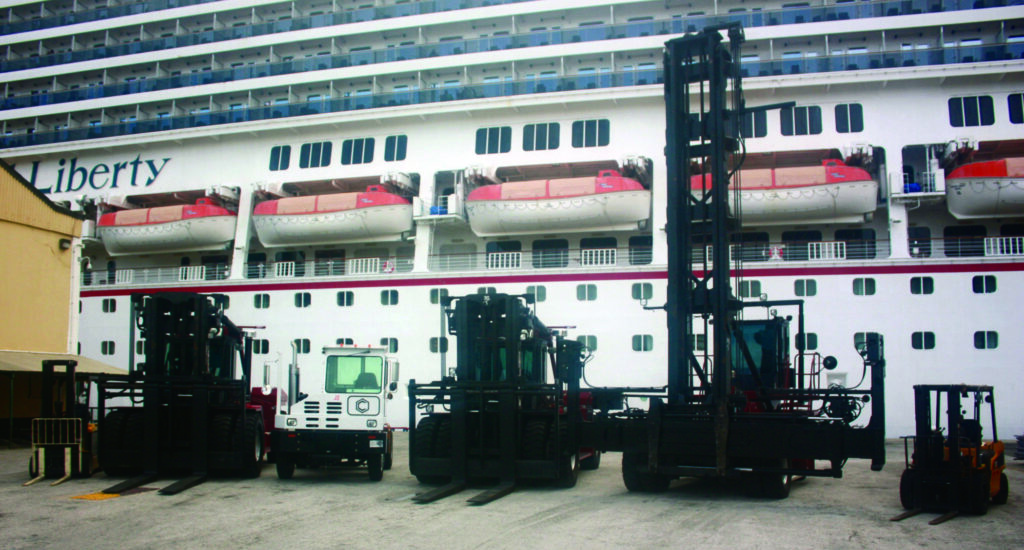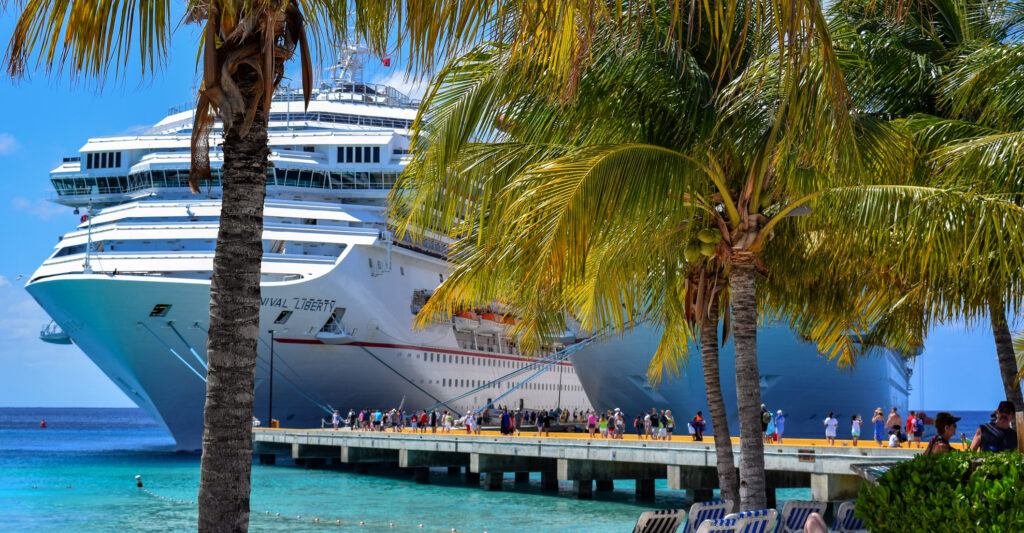CRUISE TOURISM LOGISTICS:
Enhancing the Caribbean Tourism Value Chain
This paper provides a systematic review of logistics within cruise industry and advances the argument that logistics management underpins that industry; and, that logistics can be used as a competitive advantage for the Caribbean region.
By Curtis Dennie
2019, July 1: The service sector contributes about 70% to gross domestic product (GDP) in Caribbean economies. Tourism is the largest contributor.
A recent study revealed that cruise passengers spent 3.36 billion USD in the Caribbean and some Latin American countries during the 2017/2018 season.[i] This is more than six percent higher than the record reported in the study in 2015. It also generated nearly 79,000 jobs paying more than $900 million in wage income in the 36 participating destinations.
In view of these statistics it should be noted that the main service providers in the tourism sector generate their profits mainly through logistics activities. Today we are at a historic juncture, where the tourism value chain continues to expand. It is imperative that decision-makers take another look at the logistics components of the cruise industry.
In the academic literature, research on ports has focused mainly on container port terminals while limited research is available on the cruise industry. Studies about cruise have been concentrated on the economic and policy issues and not on supply chain management issues. However, scholars have gradually come to recognize the importance of logistics in the cruise tourism sector. Similarly, decision-makers in the cruise industry have recognized the pivotal role of supply chain management activities.
Logistics is in the emergent stage of development in the academic literature. Yet, policy-makers concerned with the role of the tourism sector face difficulties in adjusting to a world in which the primary driver of tourism development is logistics. The role of the port and the activities that are associated with inbound, inland and outbound logistics of the cruise sector demand the attention of policymakers. The role of logistics in tourism has been not fully understood. Our current reality is that the region now exists in a logistics environment.
There has been a strong focus by economists and policy-makers on the number of vessels and passengers that call at regional ports. These statistics have served as indicators in the measurement of growth and the economic impact of the industry. However, the success of the cruise industry rests upon logistics management by its key stakeholders.
Logistics management is defined as that part of the supply chain involved with the planning, implementing and controlling of the efficient, effective flow and storage of goods, services, and related information from point of origin to point of consumption for the purpose of conforming to customer requirements.[ii] The cruise industry is directly involved in several logistics-related activities in the value chain. These include procurement, inventory, information ordering, transportation, homeporting and tours (land, air and sea).
The role of logistics should therefore underpin the strategies for decision-makers and practitioners. For example, homeporting is, in essence, a major logistics function that correlates the activities of arrival, disembarkation, embarkation, accommodation, hotel information processing and transportation. The tour activities are governed by logistics whereby the right persons, the right number, are transported, to the right place, at the right price, at the right time.
Value Chain Framework
Michael Porter developed the concept of the value chain in 1980, in which the framework defines the primary activities and the supporting activities of a firm. Porter’s value chain framework consisted of an interdependent system or network of activities connected by linkages.
Porter argued that firms should compete in the existing market space and execute certain activities better than others in order to gain a competitive advantage. He further argued that firms can differentiate themselves through their core competencies thereby creating value to the customer.
Scholars and researchers have noted the conceptual limitations in the value chain mode however, the model did identify critical linkages in the inbound and outbound logistics chain. The logistics value chain framework in the cruise industry consists of a number of activities related to: cruise operating, port agents, port marine operations, emergency logistics, law enforcement logistics, transportation logistics (sea, air and land tour operators, crew /passenger transfers), government ministries and entities and border agencies. Within this framework lies the region’s value proposition, strengths, weakness, opportunities and threats. Cost efficiencies, revenue generation, customer satisfaction and the appeal of the destination are critical success factors in the execution of the value chain activities.
Port Marine Logistics

Marine operations have been concerned with the maintenance of navigational aids, dredging, pilotage, tug boats, lighthouse management, berthing and unberthing, anchorage, removal of wrecks and the general safety of the harbour. The effective management of the marine department and the role of the pilots are a vital part of the logistics environment. The risk management that forms part of the logistics systems are mitigated by the expertise of the staff of the port marine operations department.
The logistical network creates predictability in the regions’ maritime environment. A failure of the logistics system can have national or regional implications for the cruise sector. The technical and logistics decisions that are made by port managers, operations managers, chief pilots, tug boat captains and berthing officers enhance safety at ports.
The high degree of coordination to execute the manning, navigation, berthing and unberthing of cruise ships signals confidence in the maritime environment. There are however the implications of the increase in the number of vessels and the growing size of cruiseships. There is a correlation between the number of vessels and the risks that are associated with the growing demand for services and the limited man power. While policy-makers seek to embrace higher numbers of vessel-calls so as to prove growth in the sector there are inherent risks. Port management must address these issues with the policy-makers.
The technical requirements for the human resource and the acquisition of local knowledge for pilots are not readily available skill sets. Local knowledge consists of (but is not limited to) port regulations, channel markers, buoys, width, depths, navigational aids, coastal features, tidal streams, prevailing winds, prohibited areas/submarine cables, pipelines etc., traffic patterns, berth, wharves and jetties, speed limits and traffic signals. Such knowledge and expertise are acquired over time thus the development of the cruise sector must match the human resource development of the port.
Bunkering is a logistics function that provides value-added services. This service must be provided within the established international guidelines and should be managed by national ports.
The seamless logistics functions that are executed by the port marine operations staff have stabilised the cruise industry in the region.
Challenges and Limitations

As cruise tourism develops, its growth and expansion impact the architecture of the regional ports. The capabilities to adjust to the growing demands of new services create an emerging environment that is flexible and adaptable. The countries of the region are limited by land mass, road network, hotel, air-logistics and port operations capabilities. Pinnock & Ajagunna identified the fragmentation of the air and maritime transport network as a challenge to the region.
The region faces several challenges which include, the diversified interest of the public and private sector, cultural barriers, resistance to change, political will, seasonality of the industry, infrastructural weakness and limited human resource capabilities in logistics management.
The key question therefore is: how can we effectively develop the levels of coordination in the logistics system that will produce profitable outcomes? Pinnock & Ajagunna proposed a holistic approach to the maritime industry that could allow the positioning the Caribbean in the global logistics and supply chain. There must be a fundamental realignment of the tourism strategy. This paradigm shift demands both a cultural and policy change. Policy change must address the issue of logistics which is closely tied to infrastructure, technology, human resource, marketing and institutional strengthening. These components should form part of the national logistics strategy which will serve as the core of economic development.
Regional Implications
Effective transportation and logistics systems allow for the efficient flow of services that facilitate tourism growth and development. Regional organizations should realize that improving logistics performance is at the core of the economic growth and competitiveness of the region. The development of logistics will facilitate a deeper integration of small island-states into the global economy. The region should have trained logisticians in the leadership of port marine operations as well as the tourism sector.
National and regional strategies have not yet fully incorporated supply chain management principles into their tourism development strategy. This failure has resulted in a regional inability to fully exploit the opportunities of logistics ever since its emergence as the key pillar in the tourism framework.
The adaptation of efficient logistics can result in significant cost-savings, time reduction and the reduction of risk exposure in the tourism sector. However, the failure to address the issues of our logistical capabilities will prevent the region from realizing its full potential. Ports therefore must be at the forefront of logistics strategies as the gate keepers of the cruise tourism sector.
The need for a broader understanding of logistics and the implementation of a performance measurements framework along the logistics value chain must be underscored. A careful evaluation of the key pressure points of the chain will identify performance gaps of national ports. The key actors must understand the urgency and vulnerabilities of the region that are associated with the logistics systems.
The Caribbean region must act quickly to identify and capitalize on opportunities in logistics thereby providing value added services in procurement, warehousing, and transportation thus filling both the value and revenue gaps. And national ports should continue to build capacity in port operations, vessel planning, berth management and response capabilities for risks in the maritime environment. []
____________________
[i] Business Research & Economic Advisors (2018) Economic Contribution of Cruise Tourism to the Destination Economies
[ii] Martin, M. (2011) Logistics and Supply Chain Management.






